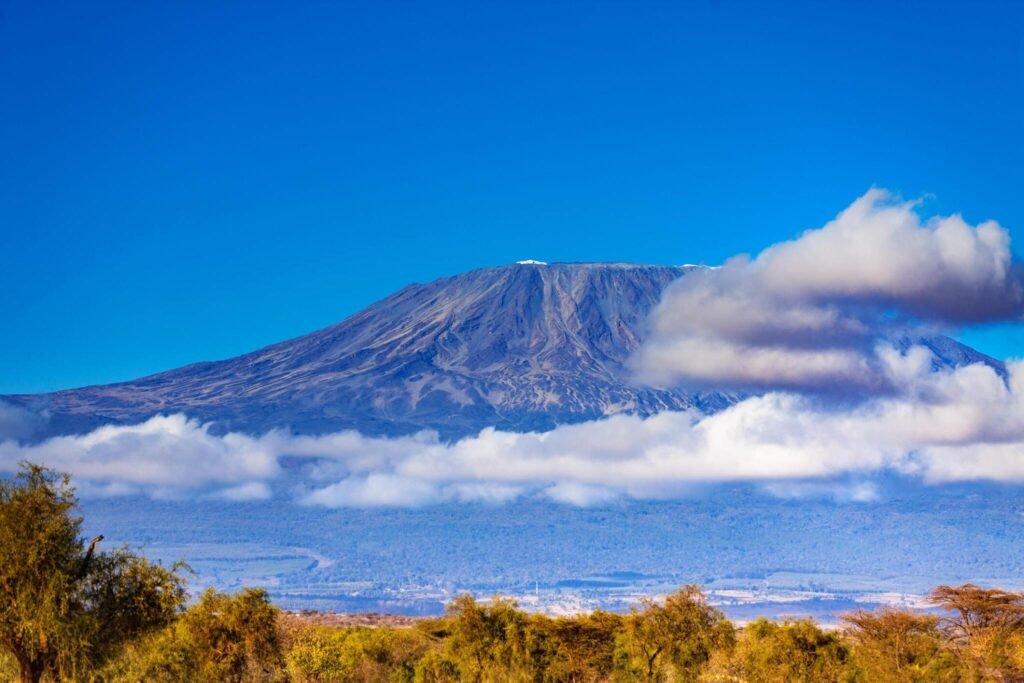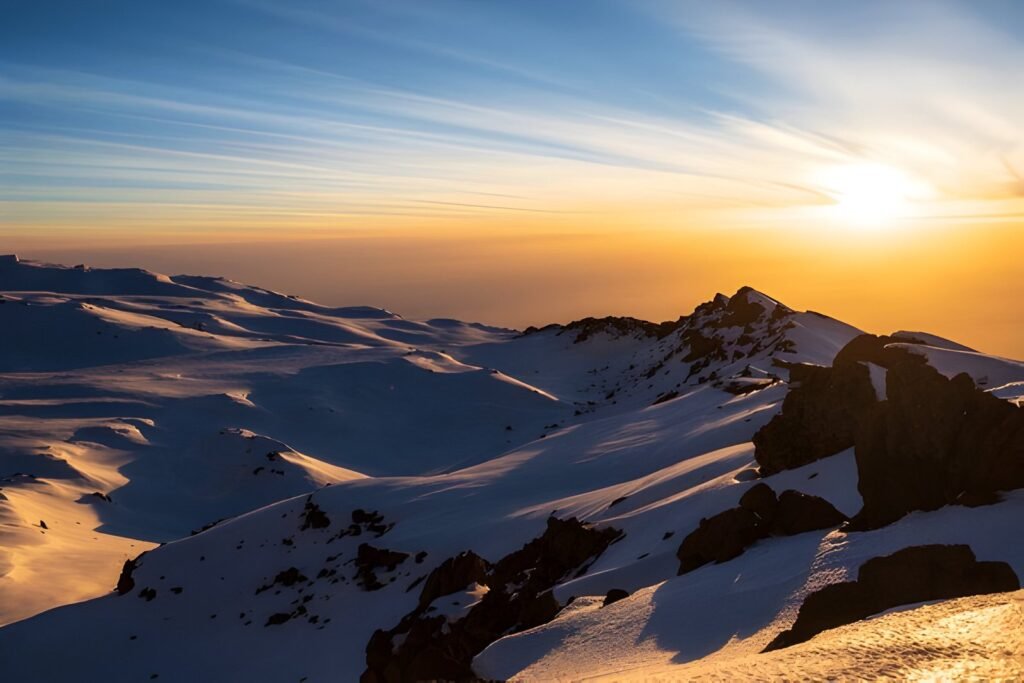The Kilimanjaro Experience : Climbing Mount Kilimanjaro, Africa’s tallest peak at 5,895 meters, is a bucket-list adventure for many. The Kilimanjaro experience is unlike any other, offering climbers breathtaking views, diverse ecosystems, and a deep sense of accomplishment upon reaching the summit. If you’re considering taking on this challenge, here’s a detailed guide to help you understand what to expect, the different routes available, and how to prepare for this life-changing journey.
Plan your Kilimanjaro climb with expert advice.

The Kilimanjaro Experience : Choosing the Right Route for Your Kilimanjaro Experience
Mount Kilimanjaro offers several routes to the summit, each varying in difficulty, duration, and scenery. Selecting the right route depends on your fitness level, how much time you have, and how you want to experience the mountain.
Popular Kilimanjaro Routes:
- Machame Route: Known as the “Whiskey Route,” it is the most popular, offering stunning scenery over 7 days.
- Marangu Route: The “Coca-Cola Route” is the easiest and the only one with hut accommodations, but it has a lower summit success rate due to its shorter acclimatization time.
- Lemosho Route: A scenic and less crowded route, taking 8 days, with a high summit success rate due to its longer acclimatization period.
- Rongai Route: Approaches from the north and is less frequented, offering a quieter climb with the possibility of spotting wildlife.
Explore the best Kilimanjaro routes and find the one for you.
The Kilimanjaro Experience : Altitude and Acclimatization on Kilimanjaro
One of the most challenging aspects of climbing Kilimanjaro is the altitude. The summit stands at nearly 6,000 meters, and the rapid ascent can lead to altitude sickness. Proper acclimatization is crucial for a safe and successful climb.
Tips for Dealing with Altitude:
- Climb Slowly: The mantra “pole pole” (slowly, slowly) is often repeated on Kilimanjaro. Ascend at a slow pace to allow your body to adjust to the altitude.
- Stay Hydrated: Drinking plenty of water helps reduce the risk of altitude sickness.
- Choose a Longer Route: Routes like Lemosho and Machame provide extra time for acclimatization, improving your chances of reaching the summit.
Learn more about altitude acclimatization and safety tips.
The Kilimanjaro Experience : What to Expect on the Climb
The Kilimanjaro experience is not just about reaching the summit—it’s about the journey. The mountain has five distinct ecological zones, each offering a unique landscape and challenge. Here’s a brief overview of what to expect during the trek:
Ecological Zones of Kilimanjaro:
- Rainforest Zone: The lower slopes of Kilimanjaro are lush and green, with dense rainforest vegetation and abundant wildlife, including monkeys and birds.
- Heather and Moorland Zone: As you ascend, the vegetation becomes sparser, with shrubs and small trees dominating the landscape.
- Alpine Desert Zone: This harsh, arid zone is rocky and barren, with little vegetation. It’s a reminder of how high you’ve climbed.
- Arctic Zone: The summit zone is freezing, with glaciers, snow, and icy winds. Temperatures can drop well below freezing at night.
Discover more about the five zones of Kilimanjaro.
The Kilimanjaro Experience : Physical and Mental Preparation for Kilimanjaro
While Kilimanjaro is not a technical climb, it requires a good level of physical fitness and mental endurance. You’ll be trekking for several hours each day, often at high altitudes, which can be physically demanding.
How to Prepare:
- Cardio and Endurance: Focus on activities like hiking, running, and cycling to build stamina.
- Strength Training: Work on leg strength, especially through exercises like squats, lunges, and stair climbing.
- Mental Toughness: Prepare yourself for long days of trekking and staying positive, especially when fatigue and altitude make the climb harder.
Get expert tips on how to train for Kilimanjaro.
The Kilimanjaro Experience : Packing the Right Gear for Kilimanjaro
Having the right gear can make or break your Kilimanjaro experience. The weather can vary drastically as you ascend, so you need to pack for all conditions—from warm daytime temperatures to freezing nights near the summit.
Essential Gear:
- Layered Clothing: Use a layering system with moisture-wicking base layers, insulating mid-layers, and a waterproof outer shell to adapt to the changing weather.
- Trekking Poles: These help reduce strain on your knees, especially during the descent.
- Good Hiking Boots: Comfortable, waterproof boots that have been broken in are essential.
- Sleeping Bag: A four-season sleeping bag is crucial to stay warm during the cold nights.
Check out the ultimate Kilimanjaro packing list.
The Kilimanjaro Experience – Summit Night: The Final Push to Uhuru Peak
The final ascent to Uhuru Peak starts just before midnight. This is the most challenging part of the climb, both mentally and physically. The temperatures can drop well below freezing, and you’ll be walking uphill in the dark, using headlamps to guide the way.
What to Expect:
- Slow and Steady: The climb to the summit is slow, and you’ll need to take frequent breaks to conserve energy and manage the thin air.
- Reaching Uhuru Peak: As the sun rises, you’ll finally reach Uhuru Peak, the highest point in Africa. The sense of achievement and the breathtaking views make all the effort worthwhile.
Learn more about summit night and what to expect.
The Kilimanjaro Experience – Returning Safely: The Descent
After reaching the summit, the descent is much faster, but it can still be tough on your legs and knees. Many climbers find the descent to be physically challenging due to the steepness and loose scree on the trails.
Tips for Descending:
- Use Trekking Poles: These will help reduce impact and prevent injuries on the way down.
- Take Your Time: While you’ll descend more quickly than you ascended, don’t rush. Descending too fast can increase the risk of altitude-related issues.
Get advice on how to descend Kilimanjaro safely.
The Kilimanjaro Experience – Kilimanjaro’s Cultural Experience
The Kilimanjaro experience isn’t just about the physical climb—it’s also an opportunity to engage with the local Chagga and Maasai cultures. Many of the guides and porters you’ll meet along the way are from these indigenous communities, and you’ll have the chance to learn about their traditions, history, and way of life.
Cultural Insights:
- Chagga People: Known for their farming skills, the Chagga live around the base of Kilimanjaro and have a deep connection to the mountain.
- Maasai: Famous for their warrior culture and colorful clothing, the Maasai live in the plains surrounding Kilimanjaro.
Discover more about the local cultures around Kilimanjaro.

The Kilimanjaro Experience : Conclusion
Climbing Mount Kilimanjaro is a once-in-a-lifetime experience that challenges both body and mind. With the right preparation, gear, and guidance, you can safely reach the summit and enjoy the incredible sense of accomplishment that comes with standing on the highest point in Africa. Whether you’re drawn by the stunning scenery, the personal challenge, or the cultural insights, the Kilimanjaro experience is unforgettable.
For expert guidance and personalized Kilimanjaro climbing packages, visit Kilimanjaro Climb Specialist or Eddy Tours & Safaris.

